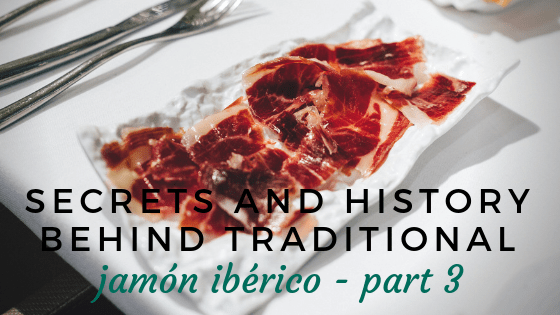SECRETS AND HISTORY BEHIND TRADITIONAL JAMÓN IBÉRICO, PART 3

To conclude our series on secrets of jamón ibérico, we are sharing some tips as to how to pick the best cuts of Spanish ham from the market. Additionally, we will give you some pointers on how to cut the perfect slice of ham from the leg. Is your mouth watering yet?
Different varieties available
We’ve already discussed the different breeds of pigs and the different grades of Spanish ham in Part 2, so let’s talk about the varieties that you will most likely find at a Spanish food market or supermarket. When you see ham at the market, it will most likely be labeled as ibérico or serrano, the grade, and also the cut. There are a few different cuts of jamón that you’ll find available to you in Spain.
Jamón: this meat comes from the back leg of the pig. You can buy a whole leg at the market or supermarket, or buy it pre-sliced and packaged.
Paleta: this meat comes from the shoulder or front leg of the pig. The curing process is shorter and the taste is not the same as the back legs.
Lomo: While not technically ham, lomo is high-quality cured pork loin from Iberian pigs.
Knowing this, you can pick the ham that’s right for you. Jamón is higher in quality and taste. It is aged longer and has a complex, nutty taste. Paleta is cured for half the time and has a stronger, more powerful aroma. Paleta is also half the price of jamón, which tends to be quite expensive.
How to pick out a good ham leg
If you want a larger quantity of ham, buying a whole leg is the way to go. It will cost you less money in the long run than buying pre-cut slices or having it sliced at the market. To buy the best leg of Spanish ham around, there are a few things that you should look for.
Appearance: the hoof of a good jamón ibérico should be black. The ankle should be thin and the leg should be stretched out, or elongated. It has an overall sleek appearance when compared to jamón serrano.
Touch: good Spanish ham shouldn’t be too hard. Make sure it has a little give when you press your finger down on it.
Color: the deeper red in color on the inside, the better the ham.
See more: Secrets and History Behind Traditional Jamón Ibérico, Part 2
Tips for slicing like a pro
To cut a Spanish ham leg, you will need a jamonera. This device perfectly holds the ham leg in place so that you can carve it with precision. Chances are you have seen one at a tapas bar or Spanish restaurant before, and maybe even watched the chef slice ham right off the leg. Cutting jamón isn’t the easiest of tasks, so be sure to have a jamonera around to help you keep a good grip on it.
Jamón ibérico is best enjoyed when it is sliced very thinly. The first thing you need to do is use a long knife to slice off the layer of fat until you reach the meat underneath. Cut the ham into small, thin pieces, trimming away the fat, but not too much. The fat holds a lot of flavor, so you don’t want to go too lean. Also, the fat holds in the flavor for later, so don’t take more off the ham than you intend to use at that moment.
The meat nearest the bone can be difficult to slice, so you’ll need to use a shorter knife for this part. Many people use the meat around the bone for cooking or stews since it usually comes off in chunks. Spanish ham is best at room temp, and is meant to be stored this way, too. Simply cover the leg with a clean kitchen cloth when you are done carving to protect the meat. Now you’re ready to serve and enjoy your delicious Spanish ham!
If you love jamón ibérico, join Food Lover Tour on a food tour to try one of Spain’s most famous tapas!
